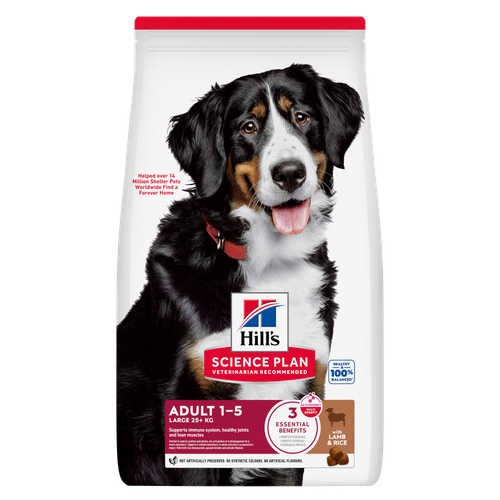
-
Find the right food for your petTake this quiz to see which food may be the best for your furry friend.Find the right food for your petTake this quiz to see which food may be the best for your furry friend.Featured products
 Adult Light Dog Food
Adult Light Dog FoodHill's Science Plan Light Adult Wet Dog Food is a complete premium pet food for adult dogs that tend to gain weight easily. This deliciously smooth loaf is formulated to deliver the appropriate amount of energy to support weight maintenance in adult dogs.
Shop Now Perfect Digestion Large Breed Puppy Food
Perfect Digestion Large Breed Puppy FoodPrecisely balanced nutrition with Hill's ActivBiome+ prebiotic blend actively contributes to supporting digestive health and overall wellbeing to help your pet feel their best
Shop Now Large Breed Adult Dog Food
Large Breed Adult Dog FoodHill's Science Plan Large Breed Adult Dog Food with Lamb & Rice is a complete pet food, specially formulated with ActivBiome+ Multi-Benefit Technology.
This food is specifically designed to fuel the energy needs of large breed dogs during the prime of their life.Shop NowFeatured products Sterilised Adult Cat Food
Sterilised Adult Cat FoodHill's Science Plan Adult Sterilised Cat Dry Food with Salmon is specially formulated with ActivBiome+ Multi-Benefit Technology. It is a precisely balanced nutrition, tailored to meet the needs of sterilised cats, to help keep sthem lean & healthy.
Shop Now Adult Cat Food
Adult Cat FoodHill's Science Plan Adult Cat Food with Chicken is a complete pet food, specially formulated with ActivBiome+ Multi-Benefit Technology.
This food is specially formulated to fuel the energy needs of cats during the prime of their life.Shop Now CULINARY CREATIONS ADULT CAT FOOD
CULINARY CREATIONS ADULT CAT FOODHill's Science Plan CULINARY CREATIONS Adult cat food with Salmon & Carrots was formulated to provide a great-tasting experience to cats. Its delicious flavour and texture are combine with essential nutrients to support cats' optimal health during the prime time of their life. Specially formulated with high-quality salmon protein, essential taurine for heart health & balanced minerals to support kidneys & bladder.
Shop Now -
Dog
- Dog Tips & Articles
-
Health Category
- Weight
- Food & Environmental Sensitivities
- Urinary
- Digestive
- Joint
- Kidney
-
Life Stage
- Puppy Nutrition
- Adult Nutrition
- Senior Nutrition
Cat- Cat Tips & Articles
-
Health Category
- Weight
- Skin & Food Sensitivities
- Urinary
- Digestive
- Kidney
-
Life Stage
- Kitten Nutrition
- Adult Nutrition
Featured articles The Incredible Science Behind Your Pet's Microbiome
The Incredible Science Behind Your Pet's MicrobiomeLearn what your pet's microbiome is, how it contributes to your pet's gut and overall health, and why nutrition is important in maintaining healthy microbiomes.
Read More Pet Nutrition: What Makes "Healthy" Pet Food Healthy? | Hill's Pet
Pet Nutrition: What Makes "Healthy" Pet Food Healthy? | Hill's PetIn people, the right diet is very important. If you are eating the wrong way for your metabolism, activity level, age and lifestyle you could end up with health issues.
Read More Microchipping: The Facts | Hill's Pet
Microchipping: The Facts | Hill's PetThe government has announced that as of April 2016, all dogs in the UK must be microchipped by law.
Read More -


You've heard of skin cancer in people, but can dogs get skin cancer? What does skin cancer look like on a dog? Dogs can develop several different types of skin cancer and, like in people, each one can have different signs. Fortunately, most skin growths in dogs are benign, ranging from fatty tumours (lipomas) to sebaceous cysts.
Can Dogs Get Skin Cancer?
Yes. According to the Royal Veterinary College, there are various types of skin cancer that can affect dogs. These include:
- Mast cell tumours. The most common tumours in dogs, mast cell tumours affect a type of white blood cell called a mast cell, which can cause cancerous growths on or under the skin.
- Carcinoma. This cancer can affect various different skin cells and is known by the type of cell affected. Examples include basal cell carcinoma and squamous cell carcinoma.
- Melanoma. This cancer affects the pigment cells that determine the colour of your dog’s skin.
- Lymphoma. This cancer originates in the lymphatic system, and is known as cutaneous lymphoma when affecting the skin.
While there's no clear answer about what causes some dogs to get skin cancer, Blue Cross describes the following risk factors:
- Sun exposure and sunburn.
- Compulsive licking of a specific area of skin.
- Genetics and breed.
Blue Cross explains that dogs with light skin, thin coats, or little fur are at the highest risk of skin cancer overall. Some breeds are also more likely to get specific types of cancer than others. For example, beagles, boxers and bulldogs are among the breeds most at risk from mast cell tumours according to the PDSA.
Likewise, benign growths are more common in some breeds; Labradors are more susceptible to lipomas, while poodles are especially prone to developing cysts. However, cancer can affect any dog breed, and it is possible to mistake some cancerous growths for benign ones. For that reason, it’s important to stay vigilant and discuss any changes in your dog’s skin with your vet.
What Does Skin Cancer Look Like in Dogs?
Can dogs get skin cancer? Yes. So, what does skin cancer look like on a dog? Blue Cross says that skin cancer can take on many different forms, ranging from lumps and bumps to scabs and warts. Marks or growth can also vary in colour.
For example, most types of skin cancer look like lumps in the skin, and they may or may not have fur. However, malignant melanoma may appear as a black or brown mark, and may be raised, like a mole, or flat. Cutaneous lymphoma, on the other hand, might present as patches of red, flaky skin, appearing similar to ringworm. Both cutaneous lymphoma and malignant melanoma can quickly become fatal and require prompt diagnosis and treatment.
If you find a lump on your dog, how much should you worry? As a general rule of thumb, any lump on your dog's skin may be cause for concern, especially if it is new or fast-growing. Say you pet your dog in that one favourite spot all the time. One day, you notice a small lump. Later, you notice that it’s grown in size. This could be a sign of trouble. Keep in mind, though, that some cancers can be firm and others can be soft, so the feel of the growth isn't a reliable indicator.


Tasty Tips
Another sign to watch for is a mass that seems to be bleeding or oozing for no reason. Your dog may or may not be bothered by this, though, so their level of interest or distress isn't generally a reliable indicator of a cancerous growth.
Diagnosing Skin Cancer in Dogs
When you bring your dog to the vet with concerning skin symptoms, the vet will likely perform a needle aspiration. This process involves sticking a needle, such as those used for vaccinations, into the mass to extract a sample of cells. Your vet can then examine the cells under a microscope, or may send the sample to a pathology specialist. Sometimes a few cells on a slide aren't enough for a diagnosis, so your vet may need to perform a biopsy on your dog or surgically remove the entire mass to send off for testing. This is the most accurate way to get a diagnosis.

Treatment for Skin Cancer in Dogs
Receiving a cancer diagnosis for your dog is never easy. Along with all of the emotions you may be feeling, you're likely wondering about next steps. What treatment is available? How can you best support your dog?
Fortunately, many types of canine skin cancer can be cured with surgical removal. If the cancer is aggressive or has spread to other parts of the body (“metastasised”), your vet may also recommend chemotherapy or radiation treatment too. It’s important to have an open discussion with your veterinarian so that you understand all of the treatment options available to you and your dog.
Early Detection Is Key
While it's not possible to completely prevent skin cancer in dogs, early detection can make a huge difference in helping your dog recover faster — and possibly live longer. To stay on top of your dog's health, give them a thorough petting session at least once a week, looking for any suspicious lumps, bumps or marks. Consider it a doggy massage! For older dogs who have many lumps, keep a chart or diagram of where and how large they are. That way, if one starts growing rapidly, you'll quickly be able to tell.
Check with your vet about any new lumps or marks. It can sometimes be difficult to relocate a tiny lump once you have your dog in the vet's office, so consider trimming the surrounding fur or even circling the lump with a pen.
Can dogs get skin cancer? While the answer is yes, you can rest easy knowing that most skin cancers in dogs are treatable. The most important thing is to monitor your dog regularly and raise any concerns with your vet promptly.


One of our staff authors prepared this article for you
Related products

Hill's Science Plan Light Adult Wet Dog Food is a complete premium pet food for adult dogs that tend to gain weight easily. This deliciously smooth loaf is formulated to deliver the appropriate amount of energy to support weight maintenance in adult dogs.

Precisely balanced nutrition with Hill's ActivBiome+ prebiotic blend actively contributes to supporting digestive health and overall wellbeing to help your pet feel their best

Hill's Science Plan Adult Wet Dog Food with Turkey is a complete premium pet food for adult dogs from 1 year. This deliciously smooth minced turkey loaf is formulated to deliver the appropriate amount of energy to support the needs of adult dogs.

Hill's Science Plan Large Breed Adult Dog Food with Lamb & Rice is a complete pet food, specially formulated with ActivBiome+ Multi-Benefit Technology.
This food is specifically designed to fuel the energy needs of large breed dogs during the prime of their life.
Related articles

Learn to see the signs of an upset stomach in your dog, understand the triggers and explore some possible solutions.

Dog obesity is a significant problem - learn more about helping your dog become trimmer and healthier through improved nutrition.
Discover the causes, signs, and treatments of kidney disease in dogs and find methods of supporting your dog's kidney health. Learn more at Hill's Pet.

Gurgling tummies in turmoil are not good news for pets. Owners who have to clean up the unfortunate consequences, digestive problems are one of the rare downsides to owning a pet.

Put your dog on a diet without them knowing
Our low calorie formula helps you control your dog's weight. It's packed with high-quality protein for building lean muscles, and made with purposeful ingredients for a flavourful, nutritious meal. Clinically proven antioxidants, Vitamin C+E, help promote a healthy immune system.
Put your dog on a diet without them knowing
Our low calorie formula helps you control your dog's weight. It's packed with high-quality protein for building lean muscles, and made with purposeful ingredients for a flavourful, nutritious meal. Clinically proven antioxidants, Vitamin C+E, help promote a healthy immune system.

